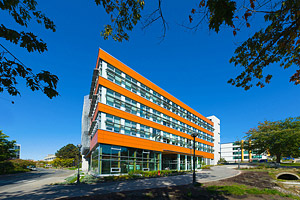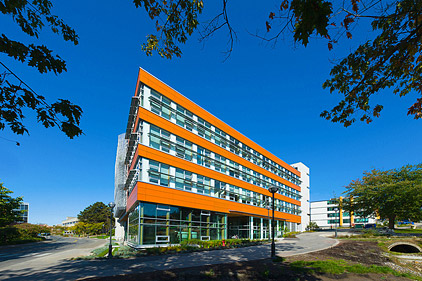
|
| The Centre for Interactive Research on Sustainability (CIRS) will test and advance sustainable technologies. (Credit: Don Erhardt/UBC) |
Honeywell, together with the University of British Columbia (UBC), celebrated the grand opening of the university’s Centre for Interactive Research on Sustainability (CIRS), a living laboratory for researchers to teach, test, and study the long-term impact of sustainable practices and technologies. Featuring advanced building controls, sensing technology, and management software from Honeywell, CIRS will serve as a leading academic hub to test and advance sustainable technologies before broader implementation, and operate as a center for green building policymakers to establish future standards.
UBC selected Honeywell as its technology provider at the outset of the planning process, and Honeywell engineers provided guidance on how to network and integrate the building systems that help manage the facility.
UBC and Honeywell also worked to ensure CIRS is one of the most sustainable buildings in the world. The research facility was built to Leadership in Energy and Environmental Design (LEED) Platinum and Living Building Challenge certification standards, the industry’s most advanced green building benchmarks.
“The university’s objective is to influence local, national, and global communities to become more sustainable,” said Dr. John Robinson, executive director of the UBC Sustainability Initiative. “From the start, Honeywell and our other Strategic Alliance Partners were dedicated to building a landmark research center that will impact the direction of eco-friendly products and strategies. The result exceeded our expectations and is a boon for UBC, and the companies and policymakers who have dedicated themselves to building a more sustainable future.”
Honeywell installed heating and cooling, fire alarm, and security systems in the building, and is using its Enterprise Building Integrator (EBI) to tie these and more than 80 other third-party systems into a single interface that will help the university operate the center more efficiently and cost effectively, and provide a robust platform for faculty and students studying the impact of various green technologies and practices.
“Research facilities like CIRS are not only going to change how buildings are constructed, controlled, and maintained, but they will produce the next generation of employees for Honeywell and the rest of the industry,” said Paul Orzeske, president of Honeywell Building Solutions. “So we’re honored to partner with UBC, and support its mission to be the world’s premier academic hub for advancing sustainable technologies and public policies.”
CIRS is utilizing the latest comfort, safety, and security technology from Honeywell, including ComfortPoint HVAC controls, XLS3000 fire alarm controls, and the Digital Video Manager surveillance system.
Honeywell EBI, a facility management platform designed to reduce operating costs by integrating building technologies across a common IT backbone, will manage the systems, and aggregate and report performance data. Researchers will use these metrics to examine how people interact with the technology to optimize the use of energy and other resources. EBI will also tie various third-party systems — such as lighting, utility metering, and rainwater collection — into the platform to provide a comprehensive view and control of all operations, which will aid researchers as well.
In addition, Honeywell will help UBC display details on the building’s energy consumption and greenhouse gas emissions on the CIRS website and a customized dashboard inside the center. And students and faculty who occupy the facility can also access a web portal to adjust temperature and lighting conditions in their individual offices and labs.
As a Strategic Alliance Partner, the company has also committed to supporting the facility and UBC’s research efforts over the next five years. This will include ongoing product development, as well as collaborating with the university to test new building technology.
For more information, visit www.honeywell.com/buildingsolutions.
Publication date: 01/09/2012


Report Abusive Comment